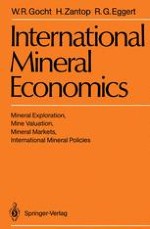International Mineral Economics provides an integrated overview of the concepts important for mineral exploration, mine valuation, mineral market analysis, and international mineral policies. The treatment is interdisciplinary, drawing on the fields of economics, geology, business, and mining engineering. Part I, Economic Geology and Mineral Development, examines the technical concepts important for understanding the geology of ore deposits, the methods of exploration and deposit evaluation, and the activities of mining and mineral processing. Part II, Mineral Economics, focuses on the economic and related concepts important for understanding mineral development, the evaluation of exploration and mining projects, and mineral markets and market models. Finally, Part III, International Mineral Policies, reviews and traces the historical development of the policies of international organizations, the industrialized countries, and the developing countries.
